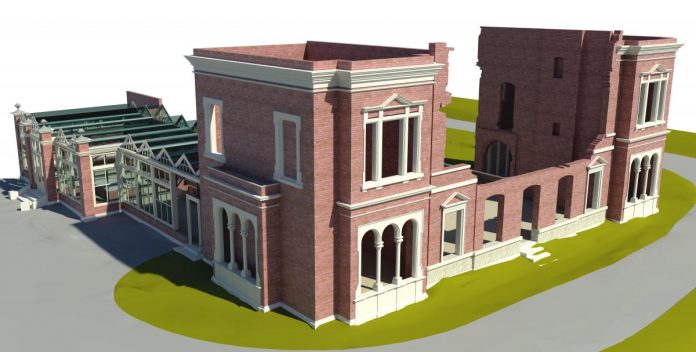BIM has a wealth of potential applications in the heritage and historic buildings sectors. Paul Bryan, Geospatial Imaging Manager at Historic England, outlines the organisation’s first technical guidance document on the subject
Historic Building Information Modelling (BIM) is, by definition, a multi-disciplinary process that requires the input and collaboration of professionals with very different skillsets. It is also a fast-developing field in terms of research, official guidance, standards and professional practice.
To help address the issues surrounding the production and use of BIM for historic buildings, Historic England recently published their first technical guidance document on the subject. BIM for Heritage: Developing a Historic Building Information Model combines guidance and information on the heritage application of BIM with a series of case studies that demonstrate its real-world application across archaeology, infrastructure and building applications.
Historic England defines the term Building Information Modelling as describing a collaborative process for the production and management of structured electronic information. Although BIM may still be a new concept for many, it is not new technology, having been in use for the last 20 years in the architectural, engineering and construction (AEC) industry, although mainly in new build buildings and infrastructure as opposed to existing buildings or the heritage sector.
English Heritage (out of which Historic England was born) started consideration of BIM in 2013 through inclusion within its Heritage Science strategy. It established its own internal, multi-disciplinary BIM Special Interest Group (BIMSIG) that considered the relevance and potential adoption of BIM across its own historic estate, and the impact BIM might have on its external advice.
Linking BIM with the heritage science strategy provided an opportunity to expand sector knowledge on the process, through developing and supporting collaborative doctoral research that currently includes Heritage BIM: New Ways of Digital Data Management for the Historic Built Environment (Joanna Hull, Reading University) and Building Information Models from Monitoring and Simulation Data in Heritage Buildings (Danae Pocobelli, UCL Institute for Sustainable Heritage).
Formation of the BIM4Heritage special interest group in 2016, established within BIM4Communities, has provided a wider forum for organisations and industry professionals to share knowledge and lessons learned on applying BIM to historic structures. This includes Historic England, who already provide a range of practical guidance on surveying, managing and caring for historic buildings and their settings, as well as specialist techniques for investigating, surveying and recording heritage.
It is recognised that the process of BIM has potential applications across all aspects of heritage, notably archaeology, building services, landscape design and management. However, in developing this guidance, the authors (Sofia Antonopoulou and Paul Bryan) concentrated on developing the Historic Building Information model, given this can refer to any use of BIM for heritage and archaeology, including applications for documentation, research, conservation and asset management.
In simple terms, BIM can be described as a process of digitally illustrating all the elements that comprise a building, typically consisting of:
Geometry (2D and 3D): Based on accurate, as existing metric survey datasets that document the position, size and dimensions of all visible surfaces, components and context of the historic asset.
Non-geometric information: Refers to the physical characteristics of the built fabric such as materials, appearance and condition, as well as intangible information such as cultural, historical and architectural values and style, age and significance. This is often seen as the most important component of any BIM dataset, given it transforms the geometric model into a valuable analysis and decision-making tool, but is often constrained or simply overlooked through the use of generic as opposed to custom derived component information.
Linked documents and data: Can include archival data, product specifications, operation and maintenance manuals, reports, condition surveys, audio and video recordings, inspection logs or any other type of digital file.
Within commercial surveying, there is common reference to developing a ‘BIM-ready’ 3D model formed as an assembly of native BIM components that represent the geometry of the existing fabric. Often, the result of ‘Scan-to-BIM’ workflows – the process of creating, manipulating and placing BIM components by directly referencing the underlying point cloud – successful application depends on the ability of BIM software to import point clouds as derived by laser scanning.
Heritage buildings often consist of highly complex geometries and architectural features that usually require more time to represent in detail than new build structures. Modelling tolerance therefore becomes an important consideration, given that it refers to how accurately a model fits and the maximum possible divergence from the as-existing survey. Level of detail (LOD) is a similarly important consideration used to describe how much geometric detail is included in the derived BIM components, ranging from LOD 1 (symbolic) through to LOD 6 (as-built).
BIM and collaborative working processes offer considerable benefits for construction and asset management, with similar potential for the heritage sector. These include assessing design options, clash detection, quantities and cost estimation, construction simulation, energy modelling, manufacture and offsite construction, project management, facilities and asset management. However, successful implementation – especially in large or complex projects – must be based on a robust IT infrastructure, including software for producing, managing, exchanging, using and archiving information derived from BIM; a sustainable strategy for long-term data management; and well thought-out workflows governed by standards and protocols.
Significant work towards the development of appropriate BIM standards for the conservation, repair and maintenance sector has been undertaken by the Council on Training in Architectural Conservation (COTAC). However, there are currently no BIM standards specifically developed for the historic buildings sector. Therefore, adopting existing BIM standards and specifications in heritage projects may not always be completely straightforward.
Questions to ask if you’re considering BIM adoption
In helping heritage users who may be considering BIM adoption for projects involving historic assets, the guidance document addresses some of the questions often asked about BIM implementation:
Are you required to procure/deliver a project using BIM?
Currently, the UK government mandate for BIM Level 2 adoption applies to all centrally procured public projects regardless of value and makes no distinction between new build and existing assets, so in theory it is applicable to heritage conservation projects.
How could you benefit from adopting BIM on a heritage project?
BIM can be a valuable tool for historic asset management and offers a robust information management framework that can be highly beneficial for heritage research and analysis.
Who will be responsible for maintaining the Asset Information Model (AIM)?
For it to be an effective asset management tool it is imperative it is maintained, checked and updated to reflect changes in the physical asset.
Do you always need a 3D geometric model?
3D enables better understanding of spaces and components that constitute a historic building, while 2D is appropriate for linking documents and data within small or less complex sites.
Can you do this yourself?
Delivering a project using BIM tools and processes, especially involving complex or significant historic assets, can be a daunting prospect. However, the adoption of BIM and collaborative working in the heritage sector requires organisations and individuals to embrace change and accept that traditional roles and practice models may need to be adapted to deliver projects successfully using BIM.
BIM for Heritage: Developing a Historic Building Information Model is free and available to download from the Historic England website.
Paul Bryan BSc FRICS
Geospatial Imaging Manager
Historic England
paul.bryan@HistoricEngland.org.uk
Twitter: @HistoricEngland
Instagram: historicengland














